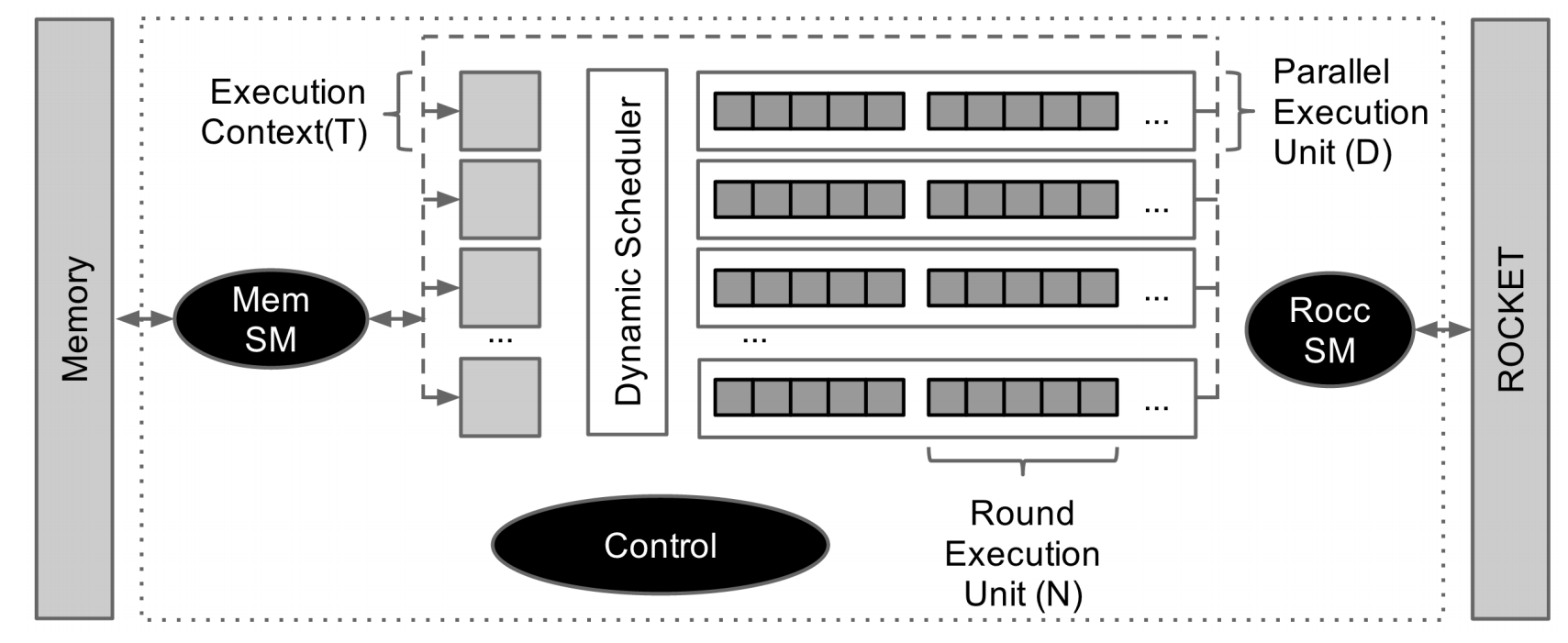3.10. SHA3 RoCC Accelerator
The SHA3 accelerator is a basic RoCC accelerator for the SHA3 hashing algorithm. We like using SHA3 in Chipyard tutorial content because it is a self-contained, simple example of integrating a custom accelerator into Chipyard.
3.10.1. Introduction
Secure hashing algorithms represent a class of hashing functions that provide four attributes: ease of hash computation, inability to generate the message from the hash (one-way property), inability to change the message and not the hash (weakly collision free property), and inability to find two messages with the same hash (strongly collision free property). The National Institute of Standards and Technology (NIST) recently held a competition for a new algorithm to be added to its set of Secure Hashing Algorithms (SHA). In 2012 the winner was determined to be the Keccak hashing function and a rough specification for SHA3 was established. The algorithm operates on variable length messages with a sponge function, and thus alternates between absorbing chunks of the message into a set of state bits and permuting the state. The absorbing is a simple bitwise XOR while the permutation is a more complex function composed of several operations, χ, θ, ρ, π, ι, that all perform various bitwise operations, including rotations, parity calculations, XORs, etc. The Keccak hashing function is parameterized for different sizes of state and message chunks but for this accelerator we will only support the Keccak-256 variant with 1600 bits of state and 1088 bit message chunks. A diagram of the SHA3 accelerator is shown below.

3.10.2. Technical Details
The accelerator is designed around three sub-systems, an interface with the processor, an interface with memory, and the actual hashing computation system. The interface with the processor is designed using the ROCC interface for coprocessors integrating with the RISC-V Rocket/BOOM processor. It includes the ability to transfer two 64 bit words to the co-processor, the request for a return value, and a small field for the function requested. The accelerator receives these requests using a ready/valid interface. The ROCC instruction is parsed and the needed information is stored into a execution context. The execution context contains the memory address of the message being hashed, the memory address to store the resulting hash in, the length of the message, and several other control fields.
Once the execution context is valid the memory subsystem then begins to fetch chunks of the message. The memory subsystem is fully decoupled from the other subsystems and maintains a single full round memory buffers. The accelerators memory interface can provide a maximum of one 64 bit word per cycle which corresponds to 17 requests needed to fill a buffer (the size is dictated by the SHA3 algorithm). Memory requests to fill these buffers are sent out as rapidly as the memory interface can handle, with a tag field set to allow the different memory buffers requests to be distinguished, as they may be returned out of order. Once the memory subsystem has filled a buffer the control unit absorbs the buffer into the execution context, at which point the execution context is free to begin permutation, and the memory buffer is free to send more memory requests.
After the buffer is absorbed, the hashing computation subsystem begins the permutation operations. Once the message is fully hashed, the hash is written to memory with a simple state machine.
3.10.3. Using a SHA3 Accelerator
Since the SHA3 accelerator is designed as a RoCC accelerator,
it can be mixed into a Rocket or BOOM core by overriding the
BuildRoCC key. The config fragment is defined in the SHA3
generator. An example configuration highlighting the use of
this config fragment is shown here:
class Sha3RocketConfig extends Config(
new sha3.WithSha3Accel ++ // add SHA3 rocc accelerator
new freechips.rocketchip.subsystem.WithNBigCores(1) ++
new chipyard.config.AbstractConfig)
The SHA3 example baremetal and Linux tests are located in the SHA3 repository. Please refer to its README.md for more information on how to run/build the tests.